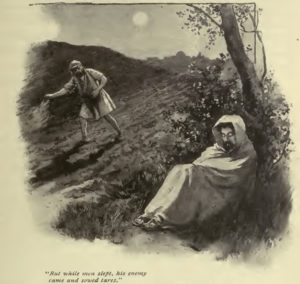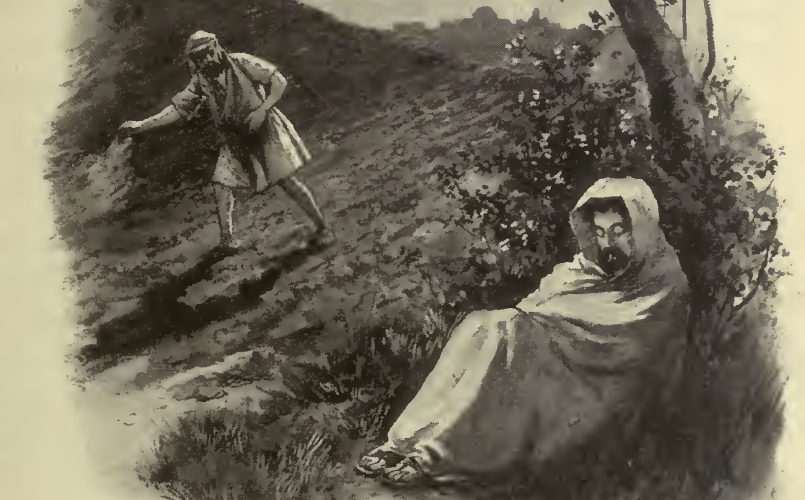Jesus’ Parable of the Tares
Podcast: Play in new window | Download
Subscribe: RSS
 TITLE: The Parable of the Tares
TITLE: The Parable of the Tares
SUBJECT: Parables of Jesus
PROPOSITION: In this lesson, we will discuss the parable of the tares.
OBJECTIVE: Each hearer will be able to explain the meaning of the parable and what questions it answers.
INTRODUCTION:
1. Read: Matthew 13:24-30
2. About the Text:
1) This parable is only found in the book of Matthew.
2) Matthew was written for the Jew.
3) The inclusion of this parable in Matthew and not in Mark and Luke meant something.
4) This parable is also one of the few where Jesus interprets the parable for the disciples.
5) Let’s see if we can learn some things from Jesus here.
3. Ref. to S, T, P, O, and A.
DISCUSSION:
I. The Parable (Matthew 13:24-30)
1. The setting.
1) A man sowed good seed in his field.
2) His enemy came and sowed tares – an injurious weed similar to wheat.
3) It would not have been immediately evident that this happened.
4) When the grain (good seed) sprouted the tares were also sprouted.
2. The servants’ questions.
1) The servants noticed the problem and questioned the owner about it.
2) The owner explained that he sowed good seed, but an enemy sowed tares.
3) The servants ask, “Do you want us to gather them up?” – to gather the tares.
3. The owners’ response.
1) Do not gather the tares because you may also destroy the wheat when you do.
a. The wheat was not ready for harvest.
b. If the plant were destroyed, it would not yield fruit.
c. Pulling out the tares at this point would decrease the harvest.
2) Let both grow together until time for harvest.
3) At the time of harvest, gather the tares and bind them for burning.
4) Gather the wheat separately to put into my barn.
II. Jesus’ Interpretation (Matthew 13:36-43)
1. The disciples ask Jesus to explain the parable.
2. In this parable, the sower is the Son of Man, Jesus.
3. The field is the world.
4. The good seed are the sons of the kingdom.
1) The seed in this parable is not the word of God as in the parable of the sower.
2) The sons of the kingdom are faithful Christians.
3) The sons of the kingdom are not the servants of verses 27-28
4) The servants are the reapers, the angels.
5. The tares are the sons of the wicked one.
1) These are the children of the devil.
2) These are either non-Christians or unfaithful Christians.
6. The harvest is the end of the age/world (Greek: ajiwvn). See verses 39 and 40.
1) Two possibilities exist for the end of the “age.”
a. The end of the Jewish age, 70 AD.
b. The end of time, the world, the future.
2) Given the language in verse 42, this seems to be talking about eternity.
3) Compare Matthew 25:30, 41.
7. The reapers are the angels (a[ggeloV).
1) These are non-human spiritual beings of power (Matthew 26:53).
2) They will be used at the end of the age to gather mankind to judgment (Matthew 25:31).
3) They are servants of God per verses 27-28 (Hebrews 1:14).
4) The servants of verses 27-28 are not the sons of the kingdom because they are the seed/plants.
8. The tares being gathered and burned in the fire is the judgment.
1) The angels will be sent by the Son of Man.
2) They will gather out of his kingdom all things that offend.
3) They will gather those who practice lawlessness.
4) They will cast them into the furnace of fire.
5) There will be weeping and gnashing of teeth.
9. The righteous will shine forth as the sun (see Daniel 12:1-3).
III. Practical Lessons
1. Martin Luther applied this parable to people in the church.
1) Many have adopted and modified this interpretation today.
2) They say that this parable means Christians are not to address apostasy in the church.
3) But what about Matthew 18:17. 1 Corinthians 5:9-13, Romans 16:17-18, 2 Thessalonians 3:6, 14.
4) These verses teach us directly that we must address apostasy in the church.
5) Jesus would be contradicting Jesus if this interpretation were true.
6) Luther’s interpretation must be false.
7) This parable does not teach that we ought to tolerate apostasy in the church.
8) This does not mean that we are to be unloving.
2. Jesus was seeking to address the attitude of condemning the righteous with the wicked.
1) The key point of the parable is that the wheat would be pulled up with the tares.
2) The parable says that it would be better to leave the tares for the sake of the righteous.
3) Consider Abraham’s pleas regarding Sodom and Gomorrah (Genesis 18:22-33).
4) Look at James and John’s attitude and Jesus’ response in Luke 9:54-56.
3. In the kingdom of God, grace and mercy is superior to justice.
1) Before the time of Christ, God often struck down the wicked.
a. Ten plagues of Egypt (Exodus 7-12).
b. The Plague when David Numbered the People (2 Samuel 24).
c. The drought in the time of King Ahab (1 Kings 17-18).
d. These punishments affected both the righteous and the wicked.
2) Today, God doesn’t immediately strike down the wicked.
a. God permits the wicked time to repent (2 Peter 3:9).
b. God wants all to be saved and come to a knowledge of the truth (1 Timothy 2:4).
3) “For judgment is without mercy to the one who has shown no mercy. Mercy triumphs over judgment” (James 2:13).
4. God’s condemnation of sinners is being reserved for the end of the world.
1) We do not see God acting directly against sinful people today.
2) One day, however, God will act.
3) Notice 2 Thessalonians 1:6-10.
4) “For we must all appear before the judgment seat of Christ, that each one may receive the things done in the body, according to what he has done, whether good or bad” (2 Corinthians 5:10).
CONCLUSION:
1. We’ve looked at the Parable of the Tares.
1) This parable is about God’s desires for man’s salvation under Christ’s rule (John 3:17)!
2) Today, He does not condemn the righteous with the wicked as in former times.
3) Grace and mercy reign now, but final judgment will eventually arrive.
2. Invitation

